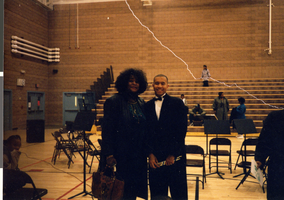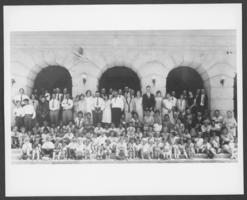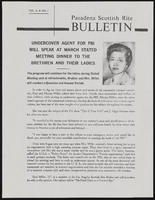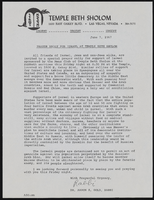Search the Special Collections and Archives Portal
Search Results

Transcript of interview with Dr. Ed Goldman by Barbara Tabach, March 22, 2016 and April 4, 2016
Date
Archival Collection
Description
In this interview, Goldman discusses the impact of strategies for addressing segregation in schools, including desegregation lawsuits, as well as anti-Semitism within the district. He also talks about his push, as region superintendent, for K through 8th grade configurations in schools as well as his opening of West Preparatory Institute, a K-12 school in Westside. Goldman discusses the politics of school naming and goes through the various community members who have schools named after them. In addition, he reflects upon how his job as a Clark County School District central office administrator has morphed over the years, and the different issues that demand his time over the years.
Edward ?Ed? Goldman was born in Rochester, New York in 1951, and spent his childhood in Jerusalem, Israel as well as Cincinnati, Ohio. He received his first bachelor?s degree in political science from Columbia University and a second in Jewish Studies from the University of Judaism. Goldman later received a master?s degree in political science from California State University, and then a doctorate in education and higher administration from UNLV, focusing on educational law. Goldman first moved to Las Vegas while on a leave of absence from his job in Los Angeles to finish his Ph.D. dissertation, working as a math teacher for the Clark County School District. However, it was not until 1981 that Goldman took a full-time position with the district, and moved with his wife, Susan, to the city. After the move, his first job was at Von Tobel Junior High School. Three years later he served as dean at Woodbury Junior High School. From 1989 until 2000, Goldman led recruitment for the school district, and subsequently, he became the Southeast Regent Superintendent. He then was asked to create a new division, Educational Services, which he oversaw for five years. He then took a break from central office administration, returning to the school environment, until he was asked to come back to his previous job as Associate Superintendent for Employee Management Relations.
Text
King, Martha Pike, 1902-1994
teacher at Boulder City High School, 1940s-1950s; her headstone and the Boulder City High School profile say Martha Pike King
Person
Anderson, Donald G., 1946-
Donald G. Anderson had a 30-year career as an elementary school teacher and administrator with the Clark County School District.
Person
Sandra F. Mack oral history interview
Identifier
Abstract
Oral history interview with Sandra F. Mack conducted by Claytee D. White on March 29, 2018 for the African Americans in Las Vegas: a Collaborative Oral History Project. In this interview, Mack discusses her early life in Seattle, Washington. She talks about her education in home economics, becoming a teacher, and her experience teaching during segregation. Mack recalls moving to Las Vegas, Nevada in 2001, and her involvement with community organizations 100 Black Women, the Las Vegas Branch of The National Association for the Advancement of Colored People (NAACP), the Urban League Guild, and the local Delta Sigma Theta chapter. Lastly, Mack talks about the 1 October shooting, gun violence, the increase of security at churches.
Archival Collection
Patricia Carmichael Craddock oral history interview
Identifier
Abstract
Oral history interview with Patricia Carmichael Craddock conducted by Joe Schneider on March 2, 1980 for the Ralph Roske Oral History Project on Early Las Vegas. Patricia Carmichael Craddock first discusses growing up in Las Vegas, Nevada where she became a teacher, the educational system in Nevada, and her colleagues. Craddock also discusses the changes to Las Vegas and how other people outside of Las Vegas perceived the city during that time. She later mentions Helldorado and the types of recreational activities available to young people during her time.
Archival Collection
Joan Olson Griffith oral history interview
Identifier
Abstract
Oral history interview with Joan Olson Griffith conducted by Sharee Schrader on April 12, 2005 for the History of Blue Diamond Village in Nevada Oral History Project. Griffith begins by discussing why she moved to Blue Diamond, Nevada with her family due to job opportunities at the Blue Diamond Plant, where they manufactured wallboard, in 1956. She describes life in Blue Diamond and rural Nevada, the education available in the village, and Blue Diamond's proximity to Bonnie Springs Ranch and structures made for the filming of Western themed media. Griffith concludes by discussing how Blue Diamond has changed since the 1950s and being a Sunday school teacher for eighteen years.
Archival Collection

Photograph of Marzette Lewis with Charles I. West Middle School band director Anthony Marentic
Date
Archival Collection
Description
Color photograph of Marzette Lewis with band director Anthony Marentic in the gym.
Image

Photograph of LDS Sunday School on steps of County Courthouse, Nevada, circa 1927
Date
Archival Collection
Description
Image


